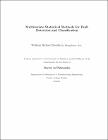Browsing Mechanical & Manufacturing Eng (Theses and Dissertations) by Title
Now showing items 125-144 of 219
-
Manipulation of decellularized porcine scaffolds for tissue engineering vascular grafts
(Trinity College (Dublin, Ireland). Department of Mechanical and Manufacturing Engineering, 2014)The prevalence of vascular disease continues to increase worldwide, the treatment for which relies heavily on diseased vessel replacement. Tissue engineering vascular grafts potentially offers a new solution for addressing ... -
Mechanical properties of diamond impregnated cobalt metal matrix
(Trinity College (Dublin, Ireland). Department of Mechanical and Manufacturing Engineering, 2011)Diamond Impregnated Metal Matrix (DIMM) composite materials are a class of materials used in cutting and drilling of stone and construction materials. This thesis examined the effects of diamond size and diamond concentration ... -
Mechanics of the linea alba and suture-based wound closure
(Trinity College (Dublin, Ireland). Department of Mechanical and Manufacturing Engineering, 2016)Over the past thirty years, there has been a dramatic change in the methodology of abdominal surgery. The introduction of digitalisation, miniaturisation, improved optics, novel imaging techniques and computerised information ... -
Mechanobiology of tissue differentiation during osteochondral defect repair
(Trinity College (Dublin, Ireland). Department of Mechanical and Manufacturing Engineering, 2004)Differentiation can be thought of as a process by which cells and tissues undergo a change in phenotype toward a more specialized form or function. It is the contention of this thesis that tissue differentiation is in some ... -
Mechanoregulated tissue organisation during skeletal repair : a computational study
(Trinity College (Dublin, Ireland). Department of Mechanical and Manufacturing Engineering, 2012)Articular cartilage is a highly specialised bearing material that provides low friction, wear resistant contact between the ends of articulating bones in diarthrodial joints. In order to function in this mechanically ... -
Mechanoregulation algorithms predicting peri-prosthetic bone adaptations
(Trinity College (Dublin, Ireland). Department of Mechanical and Manufacturing Engineering, 2007)Numerous mechanobiological algorithms have been developed in recent years to simulate biological processes such as bone remodelling and tissue differentiation. However, the implementation of such algorithms for the design ... -
Mechanoregulation of bone formation : from embryogenesis to evolution
(Trinity College (Dublin, Ireland). Department of Mechanical and Manufacturing Engineering, 2007)In summary the author's thesis is that biophysical stimuli mechanoregulate ossification events through the action of mechanosensitive genes, where mechanoregulation is an ontogenetic process which has evolved. The author ... -
Metal spinning, an incremental forming process
(Trinity College (Dublin, Ireland). Department of Mechanical and Manufacturing Engineering, 2003)Recent changes in product development processes have increased the demand for sheet metal parts manufactured in low volumes with the minimum investment in tooling. Spinning and a related process called 'incremental stretch ... -
Microcracks and the fatigue behaviour of compact bone
(Trinity College (Dublin, Ireland). Department of Mechanical and Manufacturing Engineering, 2001)Microcracking in bone acts as a stimulus for bone remodelling, contributes to the loss of bone quality in osteoporosis and is thought to play a major role in both fragility and stress fractures. This study seeks to refine ... -
Micromechanical modelling of normal, drug treated and osteoporotic bone using scanning acoustic microsopy and finite element analysis
(Trinity College (Dublin, Ireland). Department of Mechanical and Manufacturing Engineering, 2011)Ultrasonic methods were exclusively used to image cortical bone at high resolutions. A scanning acoustic microscope was used at a frequency of 150 MHz giving a resolution of 20μm. Images were taken of ovine bone samples ... -
Microphone array techniques for aeroacoustics
(Trinity College (Dublin, Ireland). Department of Mechanical and Manufacturing Engineering, 2001)The capacity for source localisation and measurement in aeroacoustics can be enhanced through the use of a microphone array. Although arrays have been used in a variety of applications, there are a number of problems ... -
Modeling of the forces in grinding from grinding wheel topography
(Trinity College (Dublin, Ireland). Department of Mechanical and Manufacturing Engineering, 2000)As the world becomes more industrialized and competition for fast, high quality production increases, the need to obtain faster manufacturing processes, while simultaneously increasing product quality, becomes increasingly ... -
Modulating mechanical cues and oxygen availability to regulate chondrogenesis within MSC laden hydrogels
(Trinity College (Dublin, Ireland). Department of Mechanical and Manufacturing Engineering, 2017)Tissue engineering is a potential alternative to conventional surgical techniques for regenerating damaged tissues that lack the ability to spontaneously repair. MSCs are a promising cell source for tissue engineering ... -
Multivariate statistical methods for fault detection and classification
(Trinity College (Dublin, Ireland). Department of Mechanical and Manufacturing Engineering, 2006) -
Noise source identification for ducted fans
(Trinity College (Dublin, Ireland). Department of Mechanical and Manufacturing Engineering, 2006)Understanding combustion noise source mechanisms, designing efficient acoustic liners and optimising active control algorithms for noise reduction requires the identification of the frequency and modal content of the ...


















